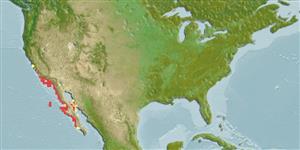>
Atheriniformes (Silversides) >
Atherinopsidae (Neotropical silversides) > Atherinopsinae
Etymology: Leuresthes: Greek, leyros, -a, -on = smooth + Greek, esthes = suit, something used to wrap (Ref. 45335).
More on author: Ayres.
Environment: milieu / climate zone / depth range / distribution range
पारिस्थितिकी
समुद्री; गहराई सीमा 0 - 18 m (Ref. 2850). Subtropical; 37°N - 24°N, 123°W - 111°W
Eastern Pacific: Monterey Bay, USA to Baja California Sur, Mexico.
Length at first maturity / आकार / वज़न / Age
Maturity: Lm 11.9 range ? - ? cm
Max length : 19.0 cm TL पुल्लिंग / अलिंग; (Ref. 2850); अधिकतम सूचित उम्र: 8 वर्षो (Ref. 1744)
पृष्ठीय रीढ़ (सम्पूर्ण): 4 - 8; पृष्ठीय सौफट रेज़ (सम्पूर्ण): 8-10; गुदा कांटा 1; ऐनल सौफट रेज़: 20 - 24; जानवरों की रीड़ का जोड़: 47 - 50. Branchiostegal rays: 6 (Ref. 36497).
Adults inhabit inshore waters, usually at or near surface along open coast and in bays (Ref. 36497). Oviparous, with planktonic primarily neustonic larvae (Ref. 36497). Eggs are deposited in the sand at night by the female parent (Ref. 58332) just below the high spring tide line (Ref. 36497). Minimum depth reported taken from Ref. 57178.
Demersal spawners. Spawn at night on sand beaches at high tides in the spring and summer. Eggs are buried in moist sand by the female parent (Ref. 58332) and hatch about 15 days later during the next series of high tides (Ref. 2850). Females spawn 4 to 8 times during a season (Ref. 4563).
Eschmeyer, W.N., E.S. Herald and H. Hammann, 1983. A field guide to Pacific coast fishes of North America. Boston (MA, USA): Houghton Mifflin Company. xii+336 p. (Ref. 2850)
IUCN Red List Status (Ref. 130435)
Threat to humans
Harmless
Human uses
Warning: mysqli::__construct(): (HY000/1040): Too many connections in /var/www/html/includes/func_getlabel.php on line 46
Can't connect to MySQL database (fbapp). Errorcode: Too many connections
